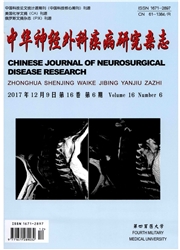

 中文摘要:
中文摘要:
目的分析106例累及鞍底硬膜的侵袭性垂体瘤的术后治疗,探讨侵袭性垂体瘤的综合治疗。方法收集我科2000年1月至2006年12月106例累及鞍底硬膜的侵袭性垂体瘤的术后患者,并随访,随访时间6~72个月。结果侵袭性垂体腺瘤MRI影像学特点为鞍底受侵下陷,部分肿瘤突入蝶窦;颈内动脉包绕;海绵窦受累,鞍隔突破等。肿瘤全切87例(82.2%),复发6例(6.7%),化疗9例,放疗8例,临床症状及生活质量明显恢复的68例(64.2%),不明显的20例(18.9%),加重的18例(17.0%)。结论侵袭性垂体瘤的治疗,手术切除是关键,术后内分泌治疗和随访十分重要,必要时辅以放疗。
 英文摘要:
英文摘要:
Objective To study the postoperative treatment of 106 patients with invasive pituitary adenomas involving sella turcica basement dura and to explore the combined therapy of invasive pituitary adenomas. Methods A total of 106 patients with invasive pituitary adenomas involving sella turcica basement dura from January 2000 to December 2006 were treated by transsphenoidal microsurgery and followed-up ( ranged from 6 to 72 months). Results MRI findings of invasive pituitary adenoina included: invasion of the sella turcica and adjacent bones, involvement of sphenoid sinus and cavernous sinus, encasement of internal carotid artery, etc. Eighty-seven eases with invasive tumors were totally resected (82. 2% ). Nine eases received chemotherapy after operation, 8 cases received radiotherapy, and 6 cases recurred (6.7%). The clinical symptoms and the quality of life were conspicuous recovered in 68 cases (64.2%), not obvious in 20 cases (18.9%), and aggravated in 18 cases ( 17. 0% ). Conclusion Operation is the key point of the treatment of invasive pituitary adenomas. Postoperative endocrine tberapy and long-term follow-up is essential, and postoperative radiotherapy should be carefully considered if necessary.
 同期刊论文项目
同期刊论文项目
 同项目期刊论文
同项目期刊论文
 期刊信息
期刊信息
